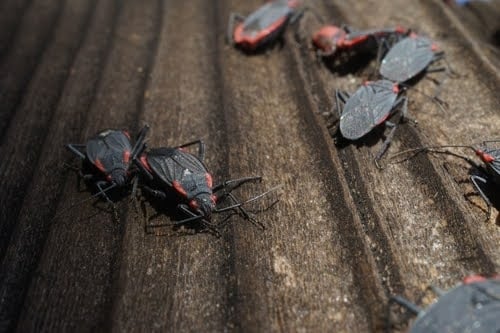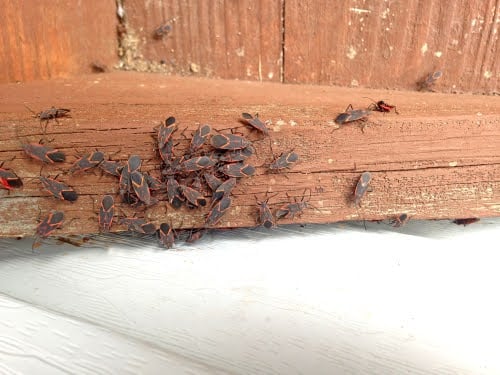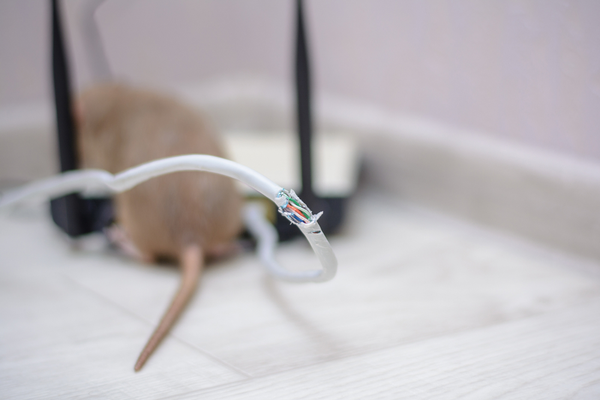In the fall, boxelder bugs are everywhere. Then, as winter arrives, these little orange and black pests begin to dwindle. Unfortunately, they haven’t disappeared and they definitely aren’t gone for good. Here’s where boxelder bugs are this winter and why you need to implement preventative measures to keep them out of your home.
Where Do Boxelder Bugs Go in the Winter?
Like most pests, boxelder bugs seek warm, sheltered spaces to survive freezing temperatures. While they don’t hibernate, they significantly reduce their activity to conserve energy. This means they’ll find cozy spots—often inside homes—to wait out the colder months.
If you’ve spotted boxelder bugs indoors during winter, it’s because they’ve entered your home to stay warm and survive. Here’s a closer look at their winter behavior:
- Surviving the Cold: Boxelder bugs don’t die off in the winter. Instead, they shelter in warm, hidden spaces like walls, attics, basements, or other small crevices in your home.
- Winter Diet: Despite being indoors, boxelder bugs don’t eat much during the winter. They rely on energy reserves stored from their feeding frenzy in the fall to sustain them through the season.
- Winter Activity: On warmer winter days, boxelder bugs may emerge from hiding to bask in the sun or wander around indoors.
Knowing their behavior and lifecycle is key to preventing future infestations. By addressing boxelder bug winter habits, you can avoid larger problems come spring.

How to Get Rid of a Boxelder Bug Infestation in the Winter
The presence of boxelder bugs in your home can be extremely frustrating. Here’s how to get rid of boxelder bugs in the winter and prevent them from making your home their retreat:
Seal Entry Points
Inspect your home for cracks and gaps around windows, doors, and utility lines. Use caulk, weatherstripping, or foam insulation to seal any potential entry points.
Eliminate Hiding Spots
Focus on areas where boxelder bugs tend to congregate, like the south side of homes (especially those that are dark colored) and around windows. Check your attic, basement, and crawl spaces for crevices they may have accessed.
Use Vacuuming for Immediate Removal
If you notice boxelder bugs inside, vacuum them up rather than squishing them. Crushed bugs release a foul-smelling liquid that can stain surfaces.
Avoid Killing Hidden Bugs
Killing boxelder bugs in hard-to-reach places can lead to odors and attract other pests. It’s best to wait for spring or get help from a professional pest control team to address hidden bugs.

How to Prevent Boxelder Bugs
To ensure you don’t deal with another infestation next year, it’s essential to take proactive steps:
- Patch Holes and Cracks: During spring and summer, inspect your home’s exterior for vulnerabilities.
- Install Screens: Cover vents, chimneys, and other access points with fine mesh to block bug entry.
- Reduce Outdoor Attractions: Boxelder bugs feed on seeds and leaves from boxelder, maple, and ash trees. Keep your yard clean and rake up fallen debris.

Plunkett’s Can Help You Get Rid of Boxelder Bugs
The best time to prevent box elder bugs is during late summer and early fall season with Plunkett's Fall Invaders program, which provides exterior treatment to reduce pest entry into your home. Preventative measures will be the most effective solution against box elders invading the home during the fall and overwintering. However if you are experiencing box elders during the winter months, we also offer targeted interior treatments which may help provide relief.
Boxelder bugs are persistent, but so are we. With proven methods and a commitment to pest-free living, you can trust Plunkett’s to keep your home protected. Don’t let boxelder bugs overstay their welcome. Contact Plunkett’s for effective, reliable solutions.








